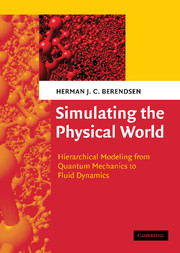Book contents
- Frontmatter
- Contents
- Preface
- Symbols, units and constants
- Part I A Modeling Hierarchy for Simulations
- 1 Introduction
- 2 Quantum mechanics: principles and relativistic effects
- 3 From quantum to classical mechanics: when and how
- 4 Quantum chemistry: solving the time-independent Schrödinger equation
- 5 Dynamics of mixed quantum/classical systems
- 6 Molecular dynamics
- 7 Free energy, entropy and potential of mean force
- 8 Stochastic dynamics: reducing degrees of freedom
- 9 Coarse graining from particles to fluid dynamics
- 10 Mesoscopic continuum dynamics
- 11 Dissipative particle dynamics
- Part II Physical and Theoretical Concepts
- References
- Index
6 - Molecular dynamics
Published online by Cambridge University Press: 05 June 2012
- Frontmatter
- Contents
- Preface
- Symbols, units and constants
- Part I A Modeling Hierarchy for Simulations
- 1 Introduction
- 2 Quantum mechanics: principles and relativistic effects
- 3 From quantum to classical mechanics: when and how
- 4 Quantum chemistry: solving the time-independent Schrödinger equation
- 5 Dynamics of mixed quantum/classical systems
- 6 Molecular dynamics
- 7 Free energy, entropy and potential of mean force
- 8 Stochastic dynamics: reducing degrees of freedom
- 9 Coarse graining from particles to fluid dynamics
- 10 Mesoscopic continuum dynamics
- 11 Dissipative particle dynamics
- Part II Physical and Theoretical Concepts
- References
- Index
Summary
Introduction
In this chapter we consider the motion of nuclei in the classical limit. The laws of classical mechanics apply, and the nuclei move in a conservative potential, determined by the electrons in the Born–Oppenheimer approximation. The electrons are assumed to be in the ground state, and the energy is the ground-state solution of the time-independent Schrödinger equation, with all nuclear positions as parameters. This is similar to the assumptions of Car–Parrinello dynamics (see Section 6.3.1), but the derivation of the potential on the fly by quantum-mechanical methods is far too compute-intensive to be useful in general. In order to be able to treat large systems over reasonable time spans, a simple description of the potential energy surface is required to enable the simulation of motion on that surface. This is the first task: design a suitable force field from which the forces on each atom, as well as the total energy, can be efficiently computed, given the positions of each atom. Section 6.3 describes the principles behind force fields, and emphasizes the difficulties and insufficiencies of simple force field descriptions. But before considering force fields, we must define the system with its boundary conditions (Section 6.2). The way the interactions over the boundary of the simulated systems are treated is in fact part of the total potential energy description.
- Type
- Chapter
- Information
- Simulating the Physical WorldHierarchical Modeling from Quantum Mechanics to Fluid Dynamics, pp. 139 - 210Publisher: Cambridge University PressPrint publication year: 2007
- 1
- Cited by



